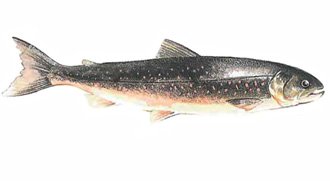Arctic char Nutrition facts
Arctic char is a cold-water fish species that belongs to the Salmonidae family, similar in appearance to Salmon and trout. It is native to the Arctic and sub-Arctic regions of North America, Europe, and Asia.
The fish is known for its distinctive pink to red-orange and tasty flesh making it a popular choice for both recreational and commercial fishing.
Its scientific name is Salvelinus alpinus.. It is one of the important fish that play a role in many northern ecosystems.
 |
| Arctic char (Salvelinus alpinus). Courtesy: Seafoodsource |
Habitat
Arctic char is a species of fish that can be either anadromous or non-anadromous, depending on the specific population. Anadromous Arctic char are fish that live in the ocean for most of their lives but return to freshwater rivers and lakes to spawn. Non-anadromous Arctic char, on the other hand, spend their entire lives in freshwater environments; typically, in freshwater environments, including rivers, lakes, and ponds.
The fish can reach a length of up to 30 inches (range in size from about 12 inches to over 40 inches) and weigh up to 20 pounds, although most individuals are smaller.
Arctic char are opportunistic feeders, consuming a variety of prey including insects, crustaceans, and small fish. They are also known to feed on plankton and algae, particularly in their juvenile stages.
Description
The body of the Arctic char is elongated and cylindrical, with a small head and a relatively large mouth. Its scales are small and densely packed, which helps protect the fish from the cold water temperatures. The back and sides of the fish are typically greenish-brown, while the belly is pale white or silver. During the breeding season, the males develop a bright red or pink coloration on their sides and belly, which is used to attract females.
Arctic char fish (Salvelinus alpinus) can vary in size, weight, and lifespan depending on factors such as their habitat, diet, and genetics. Here are some general characteristics:
Arctic char can vary greatly depending on their size and habitat. Typically, adults weigh between 1 to 2 kg (2 to 4.5 lbs), but larger specimens can weigh up to 15 kg (33 lbs) or more.
Lifespan: Arctic char have a relatively long lifespan for a fish species, with individuals living up to 20 years or more in the wild. However, their lifespan can be influenced by a range of factors, such as water temperature, food availability, and predation.
Health Benefits of Arctic char
Arctic char is a moderate calorie fish; 3.5 oz (100 g) holds 186 calories in comparison to 119 and 179 of rainbow trout and salmon respectively.
Arctic char carries a good amount of protein. Their lean meat composes 18.6 g/3.5 oz (33% of RDI) of protein, being complete in all essential amino acids in healthy proportions.
Studies suggest that consumption of seafood decreases the risk of heart attack, stroke, obesity, and hypertension. Seafood is low in saturated fat and higher in “heart healthful” polyunsaturated fat, including omega-3 fatty acids.
American Heart Association recommends consumption of at least 2 servings of oily fish to fulfill requirements of essential fatty acids, protein, minerals, and fat-soluble vitamins.
All species of Salmonidae-family fish are rich sources of vitamin A, vitamin D, and long-chain omega-3 fatty acids (PUFA).
As in other oily-fish types, Arctic char also is a rich source of omega-3 eicosapentaenoicacid (EPA), docosapantaenoicacid (DPA) and docosahexaenoic acid (DHA) fatty acids. Research studies suggest that these fatty acids, particularly DHA, play an important role in the development of neural systems, especially in infants and children.
According to Cornell University and the New York Sea Grant Extension Program. 2012- These fatty acids can help lower blood pressure and heart rate and improve cardiovascular function. For example, research has shown that omega-3 fatty acids decrease the risk of arrhythmias (abnormal heartbeats) that can lead to sudden death. Omega-3 fatty acids also decrease triglyceride levels and slow the growth rate of atherosclerotic plaque.
In adults, several large trials have evaluated the effect of fish or fish oils on heart disease. In the "GISSI Prevention Trial, heart attack survivors who took a 1-gram capsule of omega-3 fats every day for three years were less likely to have a repeat heart attack, stroke, or die of sudden death than those who took a placebo".
The essential vitamins in Arctic char contains include niacin, vitamin B6, vitamin E, vitamin B12, thiamin, and riboflavin. In addition, being an oily fish, trout has generous amounts of vitamins A and D.
Its flesh carries a good amount of vitamin D (464 IU/100g or 77% RDA) similar to salmon's (526 IU/100 g). Vitamin D plays an important role in the calcium metabolism and offers protection from cancers.
The Food and Drug Administration (FDA) recommends that pregnant women eat at least 8 ounces and up to 12 ounces (340 grams) of a variety of seafood lower in mercury a week.
It is a naturally rich source of minerals including calcium, zinc, potassium, phosphorus, iodine, and magnesium.
| Principle | Nutrient Value | Percent of RDA |
|---|---|---|
| Energy | 186 Kcal | 9% |
| Carbohydrates | 0 g | 0% |
| Protein | 18.6 g | 33% |
| Total Fat | 12.4 g | 62% |
| Saturated fatty acids | 2.21 mg | - |
| Cholesterol | 58 mg | 20% |
| Dietary Fiber | 0 g | 0% |
| Vitamins | ||
| Vitamin-D | 464 IU | 77% | Electrolytes |
| Sodium | 35 mg | 2.3% |
| Potassium | 363 mg | 7.7% |
Buying
Arctic char is a cold-water fish that is similar in appearance to salmon and trout. It is a popular fish for cooking and eating, with a mild, delicate flavor and a firm, flaky texture.
You can buy fresh or frozen, whole, trimmed, fileted, and sometimes steaks. It is also available smoked, salt-cured, or canned.
Here are some tips on how to buy Arctic char:
Look for fresh fish: When buying Arctic char, always look for fresh fish. The fish should have clear, bright eyes, shiny skin, and a fresh, clean smell. Avoid fish that have dull or cloudy eyes, dull skin, or a fishy odor.
Check the color: Arctic char can be either pink or white, depending on its diet and environment. Pink flesh indicates that the fish has been eating crustaceans, while white flesh indicates a diet of fish. Choose the color that you prefer.
Consider the source: Arctic char is available wild-caught or farmed. Wild-caught fish tend to be more expensive and have a slightly stronger flavor, while farmed fish are more widely available and tend to be milder in flavor. Consider your preferences and budget when choosing between wild-caught and farmed arctic char.
If you are unsure about how to choose arctic char, don't hesitate to ask your fishmonger for advice. They can help you choose the freshest fish and provide tips on how to cook it.
Storage
Arctic char is a delicious cold-water, oily fish that is rich in omega-3 fatty acids and protein. The best way to store arctic char is in the refrigerator for a short duration of up to 2 days. Keep it in an airtight container or wrapped tightly in plastic wrap. Place it on a plate or tray to catch any juices that may leak out.
Arctic char can be kept in the freezer for up to 6 months. Wrap the fish tightly in plastic wrap or foil and place it in an airtight container or freezer bag.
Cooking
Arctic char has a delicate and mild flavor with a firm texture, similar to salmon or trout. It can be cooked in a variety of ways, such as grilling, baking, broiling, or poaching. Arctic char can also be used in recipes that call for salmon or trout.
Thawing: When you are ready to use the Arctic char, thaw it slowly in the refrigerator. This can take anywhere from 12 to 24 hours depending on the size of the fish. Alternatively, you can place the fish in a bowl of cold water to thaw it more quickly. Change the water every 30 minutes until the fish is thawed.
Once the arctic char is thawed, it is ready to be cooked. When cooking Arctic char, it's important to not overcook it as this can cause the flesh to become dry and lose its delicate texture.
It is a delicious fish with a mild, delicate flavor and firm texture. It is a versatile fish that can be seasoned with a variety of herbs and spices to suit your taste.
Here are some serving ideas:Grilled Arctic Char with lemon and dill: Brush both sides of the arctic char fillets with olive oil and season with salt and pepper. Grill in a preheated oven for 4-5 minutes per side, or until cooked through. Remove from grill and sprinkle with chopped fresh dill and a squeeze of lemon juice.
- Pan-Seared Arctic Char with garlic and butter.
- Enjoy baked char with maple glaze.
 |
| arctic char recipe |
Safety profile
Arctic char, being seafood, may harbor microorganisms, such as parasites, bacteria, and viruses, that may cause foodborne illness. It is important to handle seafood safely to prevent foodborne illness. (Medical disclaimer).
Also read ≻≻-
≻≻- Channel Catfish nutrition facts.
≻≻- Trout nutrition facts.
≻≻- Salmon nutrition facts and health benefits.
≻≻-Back to Seafood from Arctic char nutrition facts and health benefits.
≻≻-Back to Home page.
Further reading (Links opens in new window):
U.S Fish And Wildlife Service- Alaska department of fish and game.
U.S Fish And Wildlife Service- Seafood source.
Omega-3 Fatty Acids: An Essential Contribution.